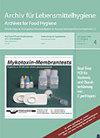1998-2007年拉脱维亚李斯特菌病10年回顾性研究
IF 0.2
4区 农林科学
Q4 CHEMISTRY, APPLIED
引用次数: 0
摘要
进行这项研究是为了描述1998年至2007年10年间拉脱维亚人类李斯特菌病的趋势,作为描述这种疾病的流行病学和临床特征的一种手段。1998年至2007年期间共发现90例李斯特菌病病例。在10年研究期间,李斯特菌病的总发病率为每10万人0.4人。总的来说,77%的临床病例以脑膜脑炎和/或败血症为特征。包括堕胎和围产期婴儿死亡在内的总死亡率为6.7%(6/90)。2000年9月至12月观察到明显的李斯特菌病聚集性病例,可能表明有一次大暴发。目前以实验室为基础的监测系统缺乏对单核细胞增生李斯特菌分离物进行分型的血清分型和分子分型方法,这是迄今为止拉脱维亚没有正式记录的李斯特菌病暴发的主要原因之一。因此,应对所有临床分离的单核细胞增生乳杆菌进行血清分型和分子分型,以尽早发现任何李斯特菌病暴发。这些措施将允许在食品工业一级采取适当行动,从而预防或大大减少拉脱维亚李斯特菌病的实际负担。本文章由计算机程序翻译,如有差异,请以英文原文为准。
A 10-year retrospective study on listeriosis in Latvia, 1998-2007
This study was undertaken to describe the trends in human listeriosis in Latvia over the 10-year period from 1998 to 2007 as a means of characterizing the epidemiological and clinical features of this disease. A total of 90 listeriosis cases were identified for the period from 1998 to 2007. During the 10-year study period the overall incidence of listeriosis was 0.4 per 100 000 of the population. Overall, 77% of all described clinical cases were characterized by meningoencephalitis and/or sepsis. The overall mortality, including abortions and perinatal infant deaths, was 6.7% (6/90). A marked clustering of listeriosis cases was observed from September to December 2000 possibly indicating one large outbreak. The lack of serotyping and molecular typing methods for subtyping of Listeria (L.) monocytogenes isolates in the present laboratory-based surveillance system is one of the main reasons why there were no officially documented listeriosis outbreaks in Latvia up to the present date. Therefore, serotyping and molecular typing should be introduced for all clinical isolates of L. monocytogenes to identify any listeriosis outbreaks as early as possible. Such measures will allow the application of appropriate actions at the food industry level, thus either preventing or significantly reducing the real burden of listeriosis in Latvia.
求助全文
通过发布文献求助,成功后即可免费获取论文全文。
去求助
来源期刊

Archiv Fur Lebensmittelhygiene
工程技术-毒理学
自引率
0.00%
发文量
0
审稿时长
>12 weeks
期刊介绍:
The "Journal of Food Safety and Food Quality“ provides a platform for papers including case studies and discussion papers dealing with topics from all areas of food hygiene (food originating from animals) including dairy hygiene, food monitoring, beef cattle and meat examination, meat hygiene and food technology.
 求助内容:
求助内容: 应助结果提醒方式:
应助结果提醒方式:


